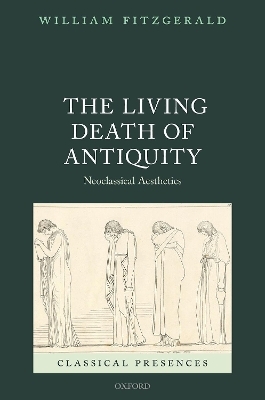
The Living Death of Antiquity
Oxford University Press (Verlag)
978-0-19-289396-3 (ISBN)
The Living Death of Antiquity examines the idealization of an antiquity that exhibits, in the words of Johann Joachim Winckelmann, 'a noble simplicity and quiet grandeur'. Fitzgerald discusses the aesthetics of this strain of neoclassicism as manifested in a range of work in different media and periods, focusing on the late eighteenth and early nineteenth centuries. In the aftermath of Winckelmann's writing, John Flaxman's engraved scenes from the Iliad and the sculptors Antonio Canova and Bertel Thorvaldsen reinterpreted ancient prototypes or invented new ones. Earlier and later versions of this aesthetic in the ancient Greek Anacreontea, the French Parnassian poets and Erik Satie's Socrate, manifest its character in different media and periods. Looking with a sympathetic eye on the original aspirations of the neoclassical aesthetic and its forward-looking potential, Fitzgerald describes how it can tip over into the vacancy or kitsch through which a 'remaindered' antiquity lingers in our minds and environments. This book asks how the neoclassical value of simplicity serves to conjure up an epiphanic antiquity, and how whiteness, in both its literal and its metaphorical forms, acts as the 'logo' of neoclassical antiquity, and functions aesthetically in a variety of media. In the context of the waning of a neoclassically idealized antiquity, Fitzgerald describes the new contents produced by its asymptotic approach to meaninglessness, and how the antiquity that it imagined both is and is not with us.
After taking a BA in Classics at Oxford (1974) and a PhD in Comparative Literature at Princeton (1980), William Fitzgerald taught for 23 years in the US, at the University of California, San Diego and Berkeley. He returned to the UK in 2003 and taught at Cambridge University until 2007, when he became Professor of Latin Language and Literature at King's College London. He has published books and articles on Latin literature, especially poetry, and on classical reception.
1: Introduction: Why Neoclassicism?
2: The Iliad Backtranslated: Alexander Pope and John Flaxman
3: Sculpture between the Graceful and the Heroic: Antonio Canova and Bertel Thorvaldsen
4: Voicing Antiquity: the Anacreontea and Charles Leconte de Lisle's Études Latines
5: Modernism, Neoclassicism, and Irony: Erik Satie's Socrate
Conclusion
| Erscheinungsdatum | 02.12.2021 |
|---|---|
| Reihe/Serie | Classical Presences |
| Zusatzinfo | 15 colour and 27 black-and-white illustrations |
| Verlagsort | Oxford |
| Sprache | englisch |
| Maße | 165 x 241 mm |
| Gewicht | 624 g |
| Themenwelt | Kunst / Musik / Theater ► Kunstgeschichte / Kunststile |
| Geschichte ► Allgemeine Geschichte ► Vor- und Frühgeschichte | |
| Geschichte ► Allgemeine Geschichte ► Altertum / Antike | |
| ISBN-10 | 0-19-289396-3 / 0192893963 |
| ISBN-13 | 978-0-19-289396-3 / 9780192893963 |
| Zustand | Neuware |
| Haben Sie eine Frage zum Produkt? |
aus dem Bereich


